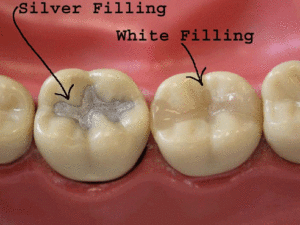Pediatric restorative treatments (fillings) in Wheat Ridge
Composite fillings for kids
Composite is a type of restorative material that we use to fill cavities. It is made of synthetic resins and is chemically bonded to the tooth structure. Most patients know composite or resin fillings as “tooth color fillings”. We prefer a composite filling over other ones because they have high aesthetic and strength qualities. The only disadvantage of a composite filling is that it requires a completely dry environment while it is being placed. So if the cavity is deep by the gum line and we can’t stop the bleeding; we cannot use the material.
Amalgam fillings for children
Amalgam is another type of restoration material that we use for filling cavities. It is a mixture of different alloys such as copper, silver, tin, and mercury. The advantages of these fillings are the great strength to wear, bacterial resistance, and ease of application. Amalgam disadvantages are lack of aesthetics and mercury controversies. We only use amalgam fillings if, due to exceptional circumstances, we absolutely cannot use composite as a filling.

Some significant differences in primary teeth (baby teeth) vs. adult teeth
The nerves in baby teeth are not as sensitive as those in adult teeth. The positive side of this is that, in most cases, we can do a filling on a baby tooth without numbing. We usually just use N2O (happy gas) to help with the vibration sensation that can occur. The drawback of the nerve not being as sensitive is that, unlike adult teeth, your child will not complain of toothaches unless the tooth is severely decayed.
The enamel layer on baby teeth is a lot thinner than that of adult teeth, thus it takes a lot less time for baby teeth to get a cavity.
Baby teeth are structurally a lot smaller than adult teeth, thus they can only handle smaller fillings before they become structurally unsound. If a baby tooth has too many surfaces with decay, we have to recommend a crown as a safe restorative choice.
Baby teeth nerves are a lot closer to the outer layer, thus it does not take very long for decay to cause nerve damage. If this occurs, we recommend to treat the nerve and then place a baby crown on the tooth.
Due to all of these significant differences, we highly recommend that children see the dentist every 6 months.

Written By: Dr. Ngo
If your child received any of these treatments please read our Post-Treatment information on fillings.
Trustindex verifies that the original source of the review is Google. Highly recommend! We've been going here for years now & I never have a complaint!Posted onTrustindex verifies that the original source of the review is Google. If you’re looking for a place that works well with kids I definitely recommend them, the staff is very welcoming and know how to make the visit fun and non scary for the kiddos! My kid leaves this place wanting to go back everytimePosted onTrustindex verifies that the original source of the review is Google. Dr Ngo and team are absolutely great with kids. They go beyond the usual cleaning and talk about jaw, bite, speech and oral health overall. We are grateful to have them local and our kids love going in!Posted onTrustindex verifies that the original source of the review is Google. Me encanta como tratan amos niñosPosted onTrustindex verifies that the original source of the review is Google. Great! took care and kept my daughter calm fast and detailed.Posted onTrustindex verifies that the original source of the review is Google. My son, had a great experience. They were great with my son who is four years old and he felt very comfortable. Great place to take your kids!Posted onTrustindex verifies that the original source of the review is Google. We have been coming to Kid Focus for years and absolutely love it!!!Posted on

